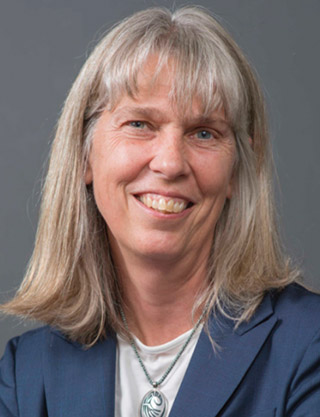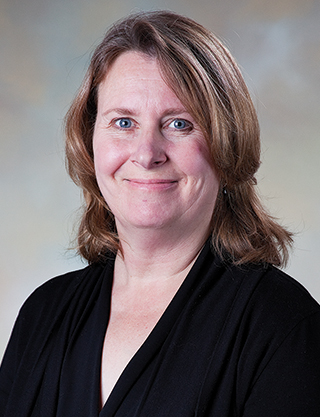Society of Women Engineers honors Sandia Labs Director Jill Hruby

Prism Award goes to Sandia physicist Christine Coverdale
The Society of Women Engineers has named Sandia President and Laboratories Director Jill Hruby the recipient of its Suzanne Jenniches Upward Mobility Award. One of the worldwide group’s top awards, it recognizes a woman with at least 20 years of experience “who has succeeded in rising within her organization to a significant management position such that she is able to influence the decision-making process and has created a nurturing environment for other women in the workplace.”
Jill says she shares the award with all of Sandia. “The Laboratory has created opportunities for me and other women like Christine Coverdale [see sidebar] that allowed our careers to thrive,” she says.
Jill joined Sandia in 1983 at the Labs’ Livermore, California, site. She worked six years in thermal and fluid sciences, solar thermal energy, and nuclear weapons components then was promoted to technical manager. Over the next eight years, she led teams focused on the maturation of certain nuclear weapon components, analytical chemistry and materials selection for nuclear weapons systems, and materials management for advanced energy storage devices including batteries and capacitors.
R&D 100 Award
Jill became a senior manager and for six years was technical deputy director, leading a portfolio of programs ranging from microtechnologies to weapons components to materials processing. In 1999 her team, in partnership with industry, won an R&D 100 award for developing radiation detectors that could make accurate measurements operating at room temperature, a technology used in X-ray radiography, environmental cleanup, nuclear materials safeguarding, treaty verification, and tumor detection.
Jill moved into executive management in 2003 as director of the Materials and Engineering Sciences department at the California site. She led a team of about 200 working in hydrogen science and engineering, and nanosystem science and fabrication. She went on to direct the Homeland Security and Defense organization, which oversaw Sandia’s programs with the Department of Homeland Security, National Institutes of Health, and numerous partners. She and her team focused on homeland work preventing and countering weapons of mass destruction, infrastructure protection, and cybersecurity.
Jill came to Sandia New Mexico in 2010 as vice president for both Div. 6000 Energy, Non-Proliferation and High Consequence Security and the International, Homeland, and Nuclear Security (IHNS) program management unit. The IHNS PMU includes projects in nuclear nonproliferation, arms control, nuclear weapons and nuclear materials security, nuclear incident response, biological and chemical defense and security, counterterrorism, and homeland security.
Five years later, Jill became the first woman to lead a national security laboratory. Sandia is the nation’s largest national lab with more than 10,000 employees and a $2.8 billion annual budget.
Collaboration has been a touchstone of her career
Collaboration inside and outside the Labs Partnership has been a constant throughout Jill’s career. She has worked to bring industry, academia, and other national laboratories into her projects. “I believe that diverse teams should work together to solve difficult problems,” she says. “Sandia is a place where, starting with leadership, people collaborate inside and outside the Labs. Partnerships create an environment where people encourage each other to succeed and reach their full potential.”
Jill has been a longtime mentor and advocate to women in engineering. She worked with the Sandia Women’s Action Network in New Mexico and the Sandia Women’s Connection in California. She has been a role model to dozens of women at the Labs and inspired them to become leaders. And through community outreach, she has encouraged female high school and college students to consider careers in engineering.
Jill will receive the SWE award at the society’s WE16, the world’s largest conference and career fair for women in engineering and technology, Oct. 27-29 in Philadelphia. About 9,000 people are expected to attend. The goal of the 30,000-member SWE is to stimulate women to achieve their full potential in careers as engineers and leaders, expand the image of the engineering profession as a positive force in improving quality of life, and demonstrate the value of diversity.
“I am honored to receive this award on behalf of Sandia, where I was encouraged every step of the way,” Jill says. “It is the kind of inclusive and supportive environment where future leaders will be developed.”
Prism Award goes to Sandia physicist

Christine Coverdale
Plasma physicist Christine Coverdale won the Society of Women Engineers (SWE) 2016 Prism Award, which honors “a woman who has charted her own path throughout her career, providing leadership in technology fields and professional organizations along the way.”
“I am very grateful for this award,” Christine (5957) says. “I have been lucky to have had many opportunities at Sandia to lead interesting and challenging projects, be mentored by highly capable people, and ultimately give back and mentor students and newer staff members.”
SWE said a Prism winner must have 15 to 20 years of experience and demonstrate outstanding leadership in her organization, exhibit a clear understanding of how her career path contributed to her achievements, work to enrich the conversation of what it means to be a successful woman in STEM, and demonstrate activities supporting SWE’s mission.
Christine joined Sandia in 1997 and in 2011 was named a Distinguished Member of the Technical Staff. She has been involved in a broad range of experiments at the Saturn and Z pulsed power facilities centered around nuclear weapons certification and other national security projects. She most recently worked on radiation detection systems and diagnostics to assess warm and hard
X-rays from Z-pinch plasmas.
Christine, who has a doctorate in plasma physics from the University of California, Davis, has authored or co-authored more than 120 papers and regularly presents at conferences. She won the 2016 IEEE Plasma Science and Applications Committee Award. She served three terms on the Executive Committee of the IEEE Plasma Science and Applications Committee and was technical program chair for the IEEE International Conference on Plasma Science in 2009, 2010, 2012, and 2015. She also served a four-year term on the IEEE Nuclear Plasma Sciences Society Administrative Committee.
Christine served a three-year term on the Executive Committee of the American Physical Society (APS) Division of Plasma Physics and is senior editor for High Energy Density Physics for IEEE Transactions on Plasma Science. She is a Fellow of both the IEEE and APS.
A mother of three, Christine has worked through IEEE and APS to include more women in technical programs and award nominations, and has promoted work-life balance. She mentors women in her field and speaks to aspiring female engineers through IEEE-sponsored diversity events. She also organizes and judges science fairs in local elementary schools.
“I have been able to take advantage of the many programs that encourage community involvement,” Christine says. “I appreciate that my family has been supportive of my career throughout, and receiving awards such as the Prism helps reinforce my belief that the skills I have developed to balance work and family are useful in both areas.”